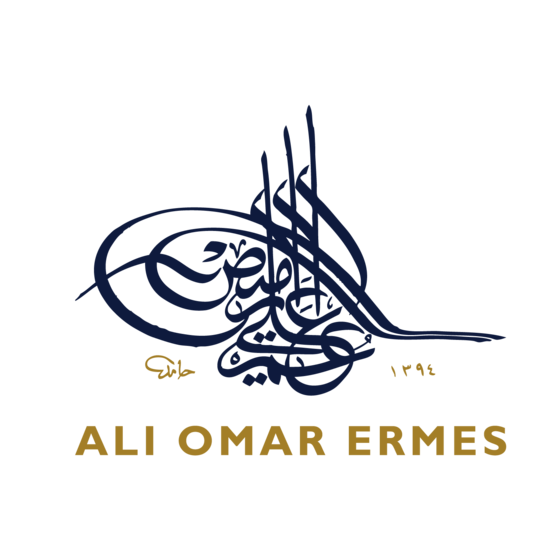Introduction to Ali Omar Ermes: Art & Ideas

By Syed Mohd Bakar b. Syed Mohd Salim, Friday 15 January 1993.
The artworks featured in this article are – ‘Visual Sounds in Arabic Script (1991) part of the Ashmolean Museum Collection, Oxford. ‘Ba Ayoon el-Akhbar’ (1992) in the collection of H.H. Sheikh Hamdan ibn Rashid Maktoom, Dubai. Qaf, “Al Alsmaie Tales” (1983) part of the collection of The National Museum of African Art, The Smithsonian Institute, Washington D.C.
I think that I have seldom been asked to write a comment about an art exhibition which has given me greater pleasure, personal and professional than this fine collection of art works by the famous painter, Ali Omar Ermes. Personal, because I feel like I have known the man for a long time even though I only met him recently in the summer of 1992 in London. Professional, because it is rare for as accomplished a painter to speak so eloquently and with simple clarity about his works.
It all started in the living room of his house in the Vale during my first visit. After a sumptuous repast which was studded with brilliant repartee from our lively and intelligent host, we were treated to rounds and rounds of steaming hot tea, thickly flavoured with fresh mint leaves from his own garden. There was good talk all the time. If you say something about art, try saying it about life. Art is one’s self, raised to an indefinable height. Life is one thing after another. The possibilities of art do not always coincide with the possibilities of life. Then the paintings, in rolls and rolls of 600gsm paper, almost as thick as cardboard were brought in by his sons from his studio in the basement. The small living room became at once transformed. A great variety of technique was presented from pure line to cascading atmospheric texture, with everything in the way of splashes, dots, curlicues and criss-crosses. The subjectivity and the emotionalism were clear enough. His paintings are changing structures which project colour from their surface into our space. They seem to set up an atmosphere of coloured light which vary with the intensity and the position of the light source and with the position and the distance of the observer.
These are works which bear his own personal signature and yet still reflect a general preoccupation with the problematic relationship between a work of art and the space it occupies. He talked all the time. Since the titles of the paintings were in Arabic, he translated them profusely into English, most of the time moving his hands as if he was painting washes of colour on each articulation. He did not regard his works as opportunities to demonstrate his undeniable dexterity with the media. The Arabic letter shapes become the primary vehicle of his sensibility a sensibility nourished by the mountains and valleys and forests of his native Libya and its villages and the traditions behind them. For him, art is close to life. He was not concerned with making pictures; for him his works were doorways which yield to the touch of a true friend. We departed as true friends with salaams and hugs and God willing, the next meeting would be in Kuala Lumpur as we promised each other.
There can be no final statement on Ermes works. You cannot explain art in ten minutes, and you cannot expect yourself to fall in love with it on the very first glance. I like the idea, for instance, of a person looking and looking at a painting until he finds himself looking ‘through’ it, ‘beyond’ it. It takes a lot of looking to get the rewards of art, but it is worthwhile in the end. Enough said. I hope that people will look at Ermes’ works for themselves, and pay very little attention to anything that I have said about them. They are made to be seen without verbiage&are made for a part of the psyche and for the intellect as well.
These few final words are written to provide the launching pad for what was to prove another kind of experience for me. I do still have vividly the impact of when I first saw his paintings in that living room; no art experience has equalled yet the influence of that vision upon me. I threw myself into a whirl of activity, getting sponsors and a gallery to exhibit his works. Ali telephoned every night; talking helped to keep him warm in the English cold winter, he joked. There were critical days too, especially during the holiday period when most people were away and shops were closed.
In the preparation of this exhibition of the works of Ali Omar Ermes, I have been the beneficiary of the labours, the kindness of many persons, many of whom were my former students from the elite Malay College in Kuala Kangsar who would deserve to be named, were it not for their wish to remain unmentioned. I owe a considerable debt to all of them too for their expertise and the painstaking attention to the details of producing such a finely illustrated catalogue. I sincerely hope that the works of art of Ali Omar Ermes will illuminate your life and bring as much pleasure for you as they did for me.
Syed Mohd Bakar b. Syed Mohd Salim, Kuala Lumpur.

